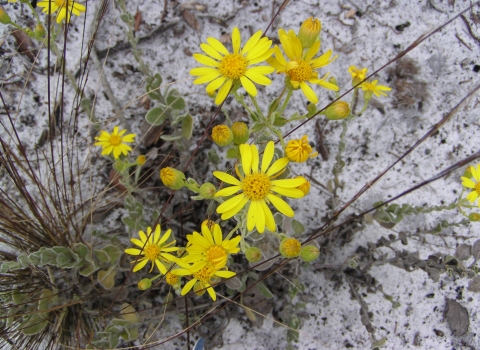What action is the U.S. Fish and Wildlife Service taking?
The U.S. Fish and Wildlife Service has evaluated the classification status of the Florida golden aster (Chrysopsis floridana), currently listed as endangered under the Endangered Species Act (ESA), and is proposing to delist the species due to recovery.
What is the Florida golden aster?
The Florida golden aster is a perennial herb. This plant grows approximately 1 to 1-1⁄2 feet tall and has yellow daisy-like blooms about 1 inch in diameter. This herb has a short life cycle and reproduces by seeds, which are dispersed by the wind.
What is this proposal to delist based on?
The proposal to delist the Florida golden aster is based primarily on the current number of populations on protected conservation lands and because the geographic distribution has exceeded the criteria in the recovery plan.
How was the Florida golden aster recovered?
This remarkable recovery success has been achieved as a result of almost 35 years of habitat acquisition and management, as well as outplanting this species in strategic areas to bolster and expand the population on those conservation lands. Because of these efforts, the aster can no longer be considered in danger of extinction or at risk of becoming so in the foreseeable future throughout all or a significant portion of its range. It no longer meets the ESA’s standard for protection.
What is the range of the Florida golden aster?
The Florida golden aster is found in very dry uplands east and southeast of the Tampa Bay area of central Florida. Its historical range is thought to span parts of Hillsborough, Manatee, Pinellas, Highlands and Hardee counties, but the true range is not known for certain because the ecosystems it occurs on were rapidly converted to residential, commercial, and agricultural uses after settlement of the region.
When the species was listed as endangered in 1986, all nine known populations of the species occurred in five locations in southeastern Hillsborough County. Since listing of the species, increased survey efforts have resulted in the discovery of additional populations, including occurrences further inland from the initial coastal populations. Many of the newly discovered locations have since been acquired as conservation lands with active conservation management activities implemented to improve habitat conditions.
Also benefiting the species, outplantings have occurred on conservation lands in Hardee, Hillsborough, Manatee, and Pinellas counties.
As of the most current surveys across the species range (2006 – 2018, depending on the population), there are 30 known populations, natural and outplanted, occurring in five counties (Hardee, Highlands, Hillsborough, Manatee and Pinellas).
What is the history of the Florida golden aster under the ESA?
This species was listed as endangered on Sept. 26, 1986 under the ESA. On Feb. 8, 1989, the Service released a recovery plan. Five-year reviews were completed in 2009 and 2017. Both indicated that the species status was improving.
How do I comment on the proposed rule?
The Service will accept comments received or postmarked on or before August 23, 2021. Comments submitted electronically using the Federal eRulemaking Portal (see ADDRESSES, below) must be received by 11:59 p.m. Eastern Time on the closing date. Requests for public hearings, must be received in writing, at the address shown in FOR FURTHER INFORMATION CONTACT by August 9, 2021.
ADDRESSES: You may submit comments on this proposed rule by one of the following methods:
- Electronically: Go to the Federal eRulemaking Portal: In the Search box, enter FWS–R4–ES–2019–0071, which is the docket number for this rulemaking. Then, in the Search panel on the left side of the screen, under the Document Type heading, click on the Proposed Rules link to locate this document. You may submit a comment by clicking on “Comment Now!”
- By hard copy: Submit by U.S. mail or hand-delivery to: Public Comments Processing, Attn: FWS–R4–ES–2019–0071, U.S. Fish and Wildlife Service, MS: BPHC, 5275 Leesburg Pike, Falls Church, VA 22041–3803.
Please send comments only by the methods described above. All comments will be posted on regulations.gov. This generally means that any personal information provided will be posted.
Document availability: The proposed rule, draft Post Delisting Monitoring (PDM) plan and supporting documents (including the Species Status Assessment (SSA), references cited, five-year review) are available on regulations.gov under Docket No. FWS–R4–ES–2019–0071.
Who can I contact if I need more information?
For additional information, contact Jay Herrington. Persons who use a telecommunications device for the deaf (TDD) may call the Federal Information Relay Service (FIRS) at 800-877-8339.




